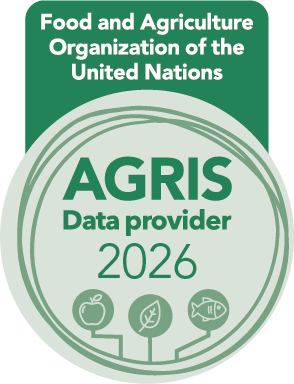Inheritance pattern of leaf and fruit traits in watermelon[Citrullus lanatus (Thunb) Mansf.]
DOI:
https://doi.org/10.24154/jhs.v20i1.3052Keywords:
Inheritance, qualitative, watermelonAbstract
Rare traits can significantly contribute to the development of trait-specific genotypes and may also be effectively used as morphological markers in breeding. Most of the watermelon cultivars or genotypes are having lobbed leaves but YF 5-2-7 exhibiting non-lobed leaves along with yellow fleshed round fruits. The study was conducted during 3 seasons to develop F1, F2 and their evaluation along with parental lines. The breeding line AHW/BR-22 was used as a female parent and crossed with unique yellow fleshed watermelon genotype YF 5-2-7 to produce F1 and F2 generation to study the inheritance of leaf hape, fruit shape and flesh colour. Based on the segregation pattern of progeny, it is concluded that leaf shape and fruit shape did not follow monogenic inheritance, while, monogenic control was observed in flesh colour. This study provides valuable insights into the genetic basis of leaf shape, fruit shape and flesh colour in watermelon, which can have practical applications in breeding programmes, facilitating the development of improved watermelon varieties with desirable and unique traits.
Downloads
References
Bang, H., Davis, A., Kim, S., Leskovar, D., & King, S. (2010). Flesh color inheritance and gene interactions among canary yellow, pale yellow, and red watermelon. Journal of the American Society for Horticultural Science, 135(4), 362–368. https://doi.org/10.21273/JASHS.135.4.362
Bang, H., Kim, S., Leskovar, D., & King, S. (2007). Development of a codominant CAPS marker for allelic selection between canary yellow and red watermelon based on SNP in lycopene b-cyclase (LCYB) gene. Molecular Breeding, 20, 63–72. https://doi.org/10.1007/s11032-006-9076-4
Chauhan, S. S. A., Choudhary, H., Yadav, R. K., Basavaraj, Y. B., Ellur, R. K., & Gupta, N. C. (2023). Genetic study of fruit quality traits in watermelon (Citrullus lanatus) prebred line derived from Citrullus lanatus var. citroid. Indian Journal of Agricultural Sciences, 93(12), 1303–1307. https://doi.org/10.56093/ijas.v93i12.141804
Choudhary, B. R. (2019). Watermelon. In K. L. Chadha (Ed.), Handbook of Horticulture (Vol. I, pp. 636–640). ICAR. ISBN: 978-81-7164-187-1
Choudhary, B. R., & Singh, P. K. (2011). Watermelon. In K. V. Peter (Ed.), Biodiversity in Horticultural Crops (Vol. III, pp. 24–42). Daya Publishing House. ISBN: 978-7035-672-1
Choudhary, B. R., Haldhar, S. M., & Saroj, P. L. (2021). AHW/BR-5 (IC0627526; INGR19079), a watermelon (Citrullus lanatus) germplasm with stable andromonoecious sex form. Indian Journal of Plant Genetic Resources, 34(1), 140.
Choudhary, B. R., Haldhar, S. M., Maheshwari, S. K., Bhargava, R., & Sharma, S. K. (2015). Phytochemicals and antioxidants in watermelon (Citrullus lanatus) genotypes under hot arid region. Indian Journal of Agricultural Sciences, 85(3), 414–417. https://doi.org/10.56093/ijas.v85i3.47179
Choudhary, B. R., Pandey, S., Rao, E. S., Singh, D., & Sharma, B. D. (2016). Characterization of variability in watermelon for DUS testing. Current Horticulture, 4(2), 30–34.
Dou, J., Zhao, S., Lu, X., He, N., Zhang, L., Ali, A., Kuang, H., & Liu, W. (2018). Genetic mapping reveals a candidate gene (ClFS1) for fruit shape in watermelon (Citrullus lanatus L.). Theoretical and Applied Genetics, 131, 947–958. https://doi.org/10.1007/s00122-018-3050-5
FAO. (2023). Food and Agricultural Organization. Rome, Italy. https://www.fao.org/faostat/en/#data
Gusmini, G., & Wehner, T. C. (2006). Qualitative inheritance of rind pattern and flesh color in watermelon. Journal of Heredity, 97(2), 177–185. https://doi.org/10.1093/jhered/esj023
Henderson, W. (1989). Inheritance of orange flesh color in watermelon. Cucurbit Genetics Cooperative Report, 12, 59–63.
Henderson, W., Scott, G., & Wehner, T. (1998). Interaction of flesh color genes in watermelon. Journal of Heredity, 89, 50–53. https://doi.org/10.1093/jhered/89.1.50
Huh, Y. C., Solmaz, I., & Sari, N. (2008). Morphological characterization of Korean and Turkish watermelon germplasm. In M. Pitrat (Ed.), Proceedings of the IXth EUCARPIA meeting on genetics and breeding of Cucurbitaceae (INRA, Avignon, France, May 21–24).
King, S. R., Davis, A. R., & Bang, H. (2009). New flesh colors in watermelon? HortScience, 44, 576. https://doi.org/10.4236/as.2013.47A003
Lv, P., Li, N., Liu, H., Gu, H., & Zhao, W. E. (2015). Changes in carotenoid profiles and in the expression pattern of the genes in carotenoid metabolisms during fruit development and ripening in four watermelon cultivars. Food Chemistry, 174, 52–59. https://doi.org/10.1016/j.foodchem.2014.11.022
Maragal, S., Rao, E. S., & Lakshmana Reddy, D. C. (2019). Genetic analysis of fruit quality traits in prebred lines of watermelon derived from a wild accession of Citrullus amarus. Euphytica, 215(12), 1–15. https://doi.org/10.1007/s10681-019-2527-x
Panse, V. G., & Sukhatme, R. V. (1985). Statistical Methods for Agricultural Workers (4th ed.). New Delhi, India.
Tanaka, T., Wimol, S., & Mizutani, T. (1995). Inheritance of fruit shape and seed size of watermelon. Journal of Japanese Society for Horticultural Science, 64(3), 543–548. https://doi.org/10.2503/JJSHS.64.543
Tindall, H. D. (1983). Vegetables in the Tropics (pp. 150–152). The Macmillan Press Limited, London.
Wang, C., Qiao, A., Fang, X., Sun, L., Gao, P., Davis, A. R., Liu, S., & Luan, F. (2019). Fine mapping of lycopene content and flesh color related gene and development of molecular marker-assisted selection for flesh color in watermelon (Citrullus lanatus). Frontiers in Plant Science, 10, 1–16. https://doi.org/10.3389/fpls.2019.01240
Zhao, W., Lv, P., & Gu, H. (2013). Studies on carotenoids in watermelon flesh. Agricultural Science, 4, 13–20. https://doi.org/10.4236/as.2013.47A003
Downloads
Published
Issue
Section
License
Copyright (c) 2025 B R Choudhary, H Ram, J Rane, S Pandey (Author)

This work is licensed under a Creative Commons Attribution-NonCommercial-ShareAlike 4.0 International License.
Authors retain copyright. Articles published are made available as open access articles, distributed under the terms of the Creative Commons Attribution-NonCommercial-ShareAlike 4.0 International License, which permits unrestricted non-commercial use, distribution, and reproduction in any medium, provided the original author and source are credited. 
This journal permits and encourages authors to share their submitted versions (preprints), accepted versions (postprints) and/or published versions (publisher versions) freely under the CC BY-NC-SA 4.0 license while providing bibliographic details that credit, if applicable.







 .
. 











